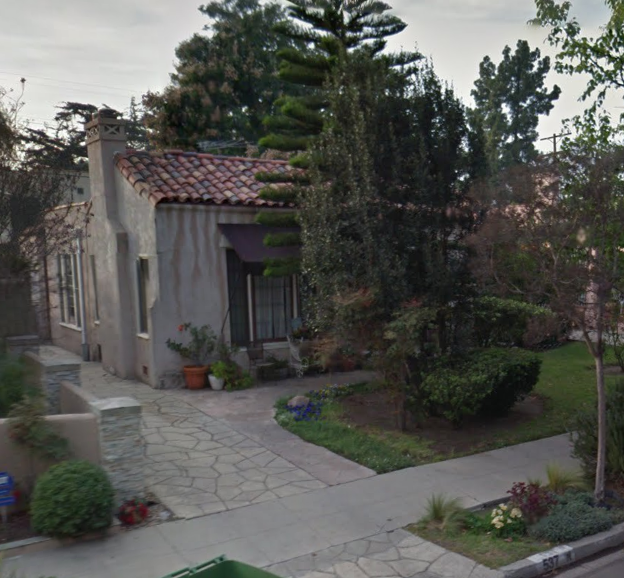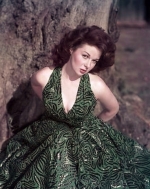
“I learned at a very early age that life is a battle. My family was poor, my neighborhood was poor. The only way that I could get away from the awfulness of life, at that time, was at the movies. There I decided that my big aim was to make money. And it was there that I became a very determined woman.” –Susan Hayward
Classic cinema has its fair share of captivating redheads and Susan Hayward is certainly one of them. Remembered today for her strong dramatic performances, Susan’s career in Hollywood almost came to an end after a failed audition for Gone with the Wind (1939). After reinventing herself and holding high standards as a professional, Susan inevitably made her mark upon Hollywood as an accomplished Academy Award-winning actress.
Susan was born Edythe Marrenner on June 30th, 1917, to Ellen and Walter Marrenner in Brooklyn, New York. According to the 1920 census, Walter worked as a telephone lineman, while Ellen was a housewife. Susan was the youngest child; her oldest sibling was her sister, Florence, followed by her brother, Walter, Jr. The Marrenners were poor and Susan often felt that her mother favored Florence. In response, Susan grew up determined to take on a career that would elevate her financial standing.

Tragically, when Susan was seven years old, she was hit by a car and fractured her hip while flying a kite with her brother. She never went to the hospital for treatment but was seen by doctors in order to receive medical attention for her injury. Her doctors informed her that she might not be able to walk again. Despite this news, Susan managed to stay mobile by being transported in a wagon. She also practiced walking with crutches and returned to school within a year. The injury, however, left her with one leg that was one-and-a-half inches shorter than the other. As a result, she had to wear a lift in her shoe to stay balanced. While her classmates often mocked her odd walk, it would soon become an iconic strut for her in her Hollywood days.
Susan attended Public School 181, where she got her start in acting, often playing the role of an older woman in school plays. She also attended Erasmus Hall High School, but soon transferred to Girls’ Commercial High School. In her spare time, Susan read voraciously and enjoyed going to the movies—particularly to view films featuring Ronald Colman. As a teenager, she was active in her school’s Dramatic Society. She not only acted in several school productions but also performed in a play for the Brooklyn Masonic Lodge. Susan was voted “Most Dramatic” by her classmates at Girls’ Commercial High School. In her free time, Susan also enjoyed designing fashions and won a $75 prize for one of her designs.
Upon her graduation, Susan attended secretarial school and worked at a textile company but did not enjoy it. She later met an illustrator and found work as a model, being featured in a major story for the Saturday Evening Post about modeling in New York. By 1937, she left for Hollywood to compete for the coveted role of Scarlett O’Hara in Gone with the Wind, after David O. Selznick spotted her on the cover of the Saturday Evening Post. Though she did not secure the role due to her lack of experience and was discouraged by David O. Selznick from pursuing acting any further, she took lessons for acting and voice and played bit parts while under contract for Warner Brothers. Her film debut arrived with an uncredited role as a starlet sitting at a table in Hollywood Hotel (1937).
When Susan moved to Paramount Pictures, she worked opposite Gary Cooper in Beau Geste (1939) in one of her first more major roles. She gradually gained more visibility, acting with Ingrid Bergman in Adam Had Four Sons (1941), and with John Wayne in both Reap the Wild Wind (1942) and The Fighting Seabees (1944). In 1944, Susan married actor Jess Barker, with whom she had two children: fraternal twin sons, Gregory and Timothy. By the end of World War II, she was a popular pinup girl with a new agent and a career on the rise.
Susan left her studio contract behind to take on a freelance career, beginning with a role as a nightclub dancer and detective in Deadline at Dawn (1946). Teaming up with producer Walter Wagner, Susan took on challenging dramatic roles in Canyon Passage (1946) and Smash-Up: The Story of a Woman (1947). Her portrayal of a singer struggling with alcoholism in Smash-Up: The Story of a Woman brought on her first Academy Award nomination. She was nominated for playing an alcoholic once again in My Foolish Heart (1949).
By the 1950s, Susan was well established as a dramatic actress, working in films such as With a Song in My Heart (1952), for which she received a Best Actress nomination once again, and The President’s Lady (1953), in which she played President Andrew Jackson’s wife. Shortly afterward, her turbulent marriage to Barker ended in divorce, while opportunities to continue portraying dramatic parts continued to arise. Susan starred in I’ll Cry Tomorrow (1955), in which she portrayed actress Lillian Roth, garnering her much attention. Interestingly, though she portrayed singers Lillian Roth and Jane Froman, Susan disliked her own singing and her voice was dubbed for both roles.
By 1957, Susan married Georgia rancher and businessman Floyd Eaton Chalkley. After offering a pivotal performance as murderer Barbara Graham in I Want to Live! (1958), Susan finally earned the Academy Award for Best Actress and decided to instead focus on her new marriage. She and her husband lived on a farm close to Carrollton, Georgia, and the couple converted to Catholicism together in 1964. The couple remained married until Chalkley’s passing in 1966. Susan relocated to Florida afterward, preferring not to live in her Georgia home without her husband.
Susan continued acting into the early 1970s. She worked alongside Dean Martin in Ada (1961) and replaced Judy Garland in the film adaptation of Valley of the Dolls (1967). She also performed on stage as part of the Las Vegas production of Mame.
Susan’s acting career neared its end when she was diagnosed with brain cancer. Her illness was allegedly a consequence of filming The Conqueror (1956), which had been shot near a nuclear testing facility. Susan had originally been slated to be part of a television series, but her illness prevented the series from being produced. As a result, what was intended to be the pilot for her series was instead the made-for-TV drama, Say Goodbye, Maggie Cole (1972). This would be Susan’s final film role. She made her last public appearance at the 1974 Academy Awards to present the Best Actress Award, with Charleton Heston supporting her. Susan passed away on March 14th, 1975.
Today, there are multiple places of importance to Susan in both Brooklyn and Los Angeles. For example, Susan and her family lived at 3507 Church Ave. in Brooklyn.

When her father died in 1938, the family soon moved to 537 N. Irving in Los Angeles, California.

Susan would later move to the 3737 Longridge Ave home in Los Angeles, which she shared with her first husband. All three of these properties remain private residences today.

Moreover, there are several locations in the Brooklyn area that echo Susan’s early life and legacy. Her elementary school, Public School 181, is still operating at 1023 New York Ave.

The Brooklyn Masonic Lodge, where Susan once performed in a play, stands at 317 Clermont Ave.
Erasmus High School, however, closed in 1994 due to poor academic scores. The building reopened as Erasmus Hall Educational Campus, housing five separate small schools in its stead. It is located at 911 Flatbush Ave in Brooklyn.
The Girls’ Commercial High School was renamed Prospect Heights High School, which stands at 883 Classon Ave. in Brooklyn.
Susan is also honored in her hometown with an honorary stone on the Brooklyn Botanic Garden’s Celebrity Path, a pathway dedicated to famous Brooklyn residents.
Finally, Carrollton, Georgia, also has its own tributes to Susan. There is a large mural of Susan painted on the side of the Cultural Arts Center, located at 251 Alabama St.
Susan’s gravesite is also located in Carrollton, in the Our Lady of Perpetual Help church cemetery at 210 Old Center Point Rd.
Though Susan is no longer with us, her legacy is certainly evident in her hometown and beyond.
This post originally appeared in Annette’s Hometowns to Hollywood column for TCM Backlot. View the original article here.






















































Pingback: Grauman’s Chinese Theatre Forecourt | Hometowns to Hollywood
Pingback: Killing John Wayne: The Making of The Conqueror | Hometowns to Hollywood
Pingback: Cecil B. DeMille’s Seafaring Epic | Cinema Sojourns